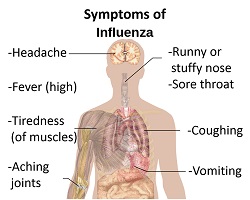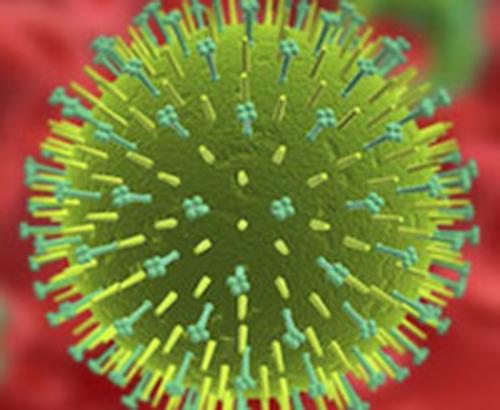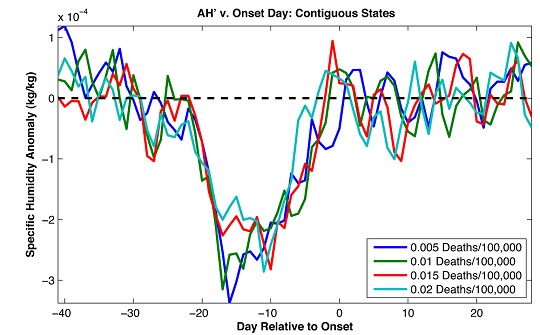
When the Flu Gets Cold
show/hide words to know
Absolute humidity: the amount of water vapor that is present in a particular volume of air.
Epidemic: occurs when new cases of a disease appear in a human population during a given period of time that infects more people than expected based on what we know about the disease.
Influenza: an infection that affects the nose, lungs, and throat. It causes symptoms like runny nose, chills, fever, and headache. It is more commonly known as the flu.
Morbidity: the rate that a disease or illness affects a group of people.
Simulate: to look like, take the shape of, or sound like something else; imitate.
Transmission: the act of passing something from one thing to another.
Virus: a super tiny germ that you can only see with a microscope. Viruses need a host in order to reproduce... more
What’s in the Story?
If you have the flu and sneeze, it's possible to spread the virus by releasing particles into the air. Covering your nose when you sneeze can help prevent the spread of the flu. Image by the Center for Disease Control.
It’s a chilly fall day in late November. You’re racing toward the front door to meet with friends, and you hear your mom yelling from the other room. She tells you to bundle up before going outside into the cold. You grumble to yourself as you put on another layer of clothing before you finally leave the house.
As it turns out, moms do know best. Have you ever noticed that more people are prone to getting the flu during the wintertime than during the summertime? Why might that be? Perhaps it is due to how hectic the winter holidays can be. We might be busy traveling to see family or going outside more often to enjoy the snow with friends. Or, perhaps it actually is the cold weather that increases our chances of getting the flu.
In the PLOS Biology article, “Absolute Humidity and the Seasonal Onset of Influenza in the Continental United States,” scientists studied the relationship between the spread of influenza, commonly known as the flu, and how humid it is outside. Changes in temperature can directly affect the amount of humidity in the air. Scientists believed that humidity might affect how well the flu is able to survive and spread.
What is the Flu?
Before we begin, let’s talk a little bit about the flu. We know that it makes people sick, but what exactly is it? The flu is a contagious illness that is caused by the flu virus. Viruses can be spread many different ways. Coughing, sneezing, or just touching something that has the flu virus on it can cause the virus to spread.
There are three types of flu viruses: A, B, and C. Only types A and B are common in humans. Generally, the flu is not very serious, and most people recover pretty quickly. However, some people can develop other illnesses from the flu that can be very serious.
It is possible for many things to play a part in determining how many people get the flu and how severe the symptoms can be. These can include the person’s age and whether they are already sick with another illness. It also depends on which flu virus is spreading, where it spreads, and when it spreads.
Brr, it’s Cold in Here! Maybe It's Too Dry in the Atmosphere!

The flu can cause fever, aches, headache, and coughing. Symptoms can appear quickly after exposure to the flu virus. Image modified from the Center for Disease Control.
Think about when you take a hot shower with the bathroom door closed. When you step out of the shower, the air feels wet and heavy. This is what humidity feels like. Humidity is the amount of water vapor that is present in the air.
Temperature affects the amount of water vapor that the air can hold. When the weather is warmer the air can hold more water vapor and there is more moisture present. Alternatively, when it's colder outside there is less water vapor in the air and thus less moisture is present.
Previous studies have shown that the flu survives and spreads better when the air is dry. This suggests that the flu might survive better when the humidity is low. Typically, humidity is lowest during the wintertime when the air is very cold and dry. These seasonal changes in humidity might explain why more people get sick from the flu during the winter.
Who Has the Flu?
Scientists started their investigation by studying the spread of the flu across the United States (except Hawaii and Alaska). They looked at how many people were sick with the flu during each winter season between 1972 and 2002. Additionally, they looked at when these people became sick with the flu.
During most winter seasons, flu symptoms started around a time that absolute humidity was low. This low absolute humidity occurred about 4 weeks before the date when flu symptoms started. These findings led scientists to believe that maybe the low absolute humidity somehow helped the flu virus to survive and spread during the wintertime.
Which State is Cooler?
There seemed to be a connection between low humidity and the spread of flu. However, scientists were unsure if humidity was definitely what was helping the flu to spread. What they needed was a way to test whether it was the low absolute humidity causing the flu to spread more readily or if it was due to something else. Scientists would need to try to model both the weather and the spread of the flu, but how is this possible? This would be very difficult to do in real life, and so scientists went virtual.

The flu is more common in the wintertime, when the air is colder and drier. Image by Petritrap.
Scientists used a computer model to simulate the spread of the flu. The virtual simulation also gave them the ability to see how climate type affects spread. Scientists chose five states, including Arizona, Florida, Illinois, New York, and Washington. Each of these states have very different climates and humidity levels.
If low absolute humidity really was the main cause of the flu’s increased rate of survival and spread, then the states with lower absolute humidity levels should have higher levels of flu spread. Alternatively, the states with higher absolute humidity levels should have lower levels of flu spread.
Florida was the most humid of the five states that the scientists studied. They found that Florida also had the lowest levels of flu survival and spread. This finding supported the hypothesis that low levels of humidity were responsible for the spread of the flu. Importantly, the results also showed that the flu spread more during winter months in all five states.
Staying Healthy
This study showed that when there is less absolute humidity in the air, it is easier for the flu virus to survive and spread. This means that it's more likely that you can catch the flu virus and get sick when it’s cold outside. With this in mind, it's extra important to wash your hands after you cough or sneeze around this time of year to avoid spreading the flu. Lastly, remember to bundle up the next time you're going out to play on a cold day and you'll be more likely to avoid catching the flu.
Additional images via Wikimedia Commons. Thumbnail of person sneezing by Mcfarlandmo. Influenza 3-D model by Eraxion.
View Citation
Bibliographic details:
- Article: When the Flu Gets Cold
- Author(s): Chanapa Tantibanchachai
- Publisher: Arizona State University School of Life Sciences Ask A Biologist
- Site name: ASU - Ask A Biologist
- Date published: June 21, 2014
- Date accessed: April 17, 2024
- Link: https://askabiologist.asu.edu/plosable/does-flu-virus-prefer-cold-weather
APA Style
Chanapa Tantibanchachai. (2014, June 21). When the Flu Gets Cold. ASU - Ask A Biologist. Retrieved April 17, 2024 from https://askabiologist.asu.edu/plosable/does-flu-virus-prefer-cold-weather
Chicago Manual of Style
Chanapa Tantibanchachai. "When the Flu Gets Cold". ASU - Ask A Biologist. 21 June, 2014. https://askabiologist.asu.edu/plosable/does-flu-virus-prefer-cold-weather
Chanapa Tantibanchachai. "When the Flu Gets Cold". ASU - Ask A Biologist. 21 Jun 2014. ASU - Ask A Biologist, Web. 17 Apr 2024. https://askabiologist.asu.edu/plosable/does-flu-virus-prefer-cold-weather
MLA 2017 Style

Be Part of
Ask A Biologist
By volunteering, or simply sending us feedback on the site. Scientists, teachers, writers, illustrators, and translators are all important to the program. If you are interested in helping with the website we have a Volunteers page to get the process started.








